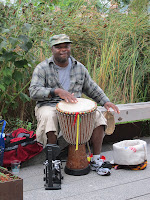 |
| Yee-ha! Manhattan cowboy! (Courtesy www.thehighline.org) |
One of the items on my
local bucket list is walking on the High Line in New York City. This past
Sunday, my immediate family and I did just that.
For those of you not from the New York City area,
here’s a little history on the High Line, courtesy of www.thehighline.org.
The High Line was built in the 1930s, as part of an
infrastructure project called the West Side Improvement. It was an elevated
freight rail line that operated 30 feet above street level, removing dangerous
trains from the streets of Manhattan's largest industrial district.
The original train lines, constructed in 1847, were built at ground
level. Unfortunately, from 1851 to 1929, so many collisions occurred between trains
and street-level traffic that 10th Avenue became known as
Death Avenue (very Goth). For safety, men on horses, called the West Side Cowboys, would ride
in front of trains waving red flags (see above photo).
 After years of public debate about the hazard, the
City and State of New York and the New York Central Railroad agreed upon the
West Side Improvement Project, which included the High Line. (Back in the day when
building/maintaining infrastructure was seen as a good thing.) The
entire project was 13 miles long, eliminated 105 street-level railroad
crossings and added 32 acres to Riverside Park. It cost over $150 million in
1930 dollars—more than $2 billion today.
After years of public debate about the hazard, the
City and State of New York and the New York Central Railroad agreed upon the
West Side Improvement Project, which included the High Line. (Back in the day when
building/maintaining infrastructure was seen as a good thing.) The
entire project was 13 miles long, eliminated 105 street-level railroad
crossings and added 32 acres to Riverside Park. It cost over $150 million in
1930 dollars—more than $2 billion today.  |
| Residents decorate windows for passers by. |
In 1934, the High Line opened,
running from 34th Street to St. John’s Park Terminal at Spring Street. It
connected directly to factories and warehouses, allowing trains to roll right
inside buildings. Milk, meat, produce, and raw and manufactured goods were
transported without causing street-level traffic.
Unfortunately, the advent of the car and its corollary, the truck, had a
chilling effect on mass transportation. As interstate trucking grew in the 1950s, the volume of rail
traffic dropped in New York and nationally. In the 1960s, with our usual panache for
disregarding history and razing everything in sight, the southernmost section
of the High Line was demolished. The last train ran on the remaining tracks in
1980. Ironically, it was pulling three carloads of frozen turkeys.
 |
| Architecture along the park is fascinating. |
No trains have run on the High Line since. Fortunately,
a group of New Yorkers had a vision for the derelict tracks, which were under the threat of demolition in the late 1990s. What they proposed was to keep the structure, which was essentially
sound, and turn it into a park.
 |
| A drummer enjoys the day. |
The project gained the city's support in 2002. The
High Line south of 30th Street was donated to the city by CSX Transportation
Inc. in 2005. The design team of landscape architects James Corner Field
Operations, with architects Diller Scofidio + Renfro, created the High Line's appearance with guidance from a community of enthusiastic High Line supporters.
Construction
on the park began in 2006. The first section, from Gansevoort Street to West
20th Street, opened June 9, 2009. The second section, from West 20th Street to
West 30th Street, opened in spring, 2011.
 |
| One section of the High Line has windows out onto the street. |
Elevated rail platforms are being converted into
parks in other cities as well. The city of Paris successfully
converted a similar rail viaduct into an elevated park called the Promenade
Plantée in 1993. Projects similar to the High Line are in early stages in St. Louis,
Philadelphia, Jersey City, Chicago and Rotterdam.
 About one third of the remaining track remains undeveloped. While
the High Line's use as a park is secure below West 30th Street, the future of
the northernmost section, around the West Side Rail Yards, depends upon plans
now being developed by the State-run MTA and a private
developer. This section of the High Line (West 30th Street to West 34th Street) may be fully preserved, altered or removed. As someone who has had the
opportunity to enjoy this wonderful park, my vote would be to expand the park
rather than remove the tracks. After all, the platform is structurally sound
and architecture of this magnitude is unlikely to reappear any time soon.
About one third of the remaining track remains undeveloped. While
the High Line's use as a park is secure below West 30th Street, the future of
the northernmost section, around the West Side Rail Yards, depends upon plans
now being developed by the State-run MTA and a private
developer. This section of the High Line (West 30th Street to West 34th Street) may be fully preserved, altered or removed. As someone who has had the
opportunity to enjoy this wonderful park, my vote would be to expand the park
rather than remove the tracks. After all, the platform is structurally sound
and architecture of this magnitude is unlikely to reappear any time soon.  |
| The Statue of Liberty peeks through the opening to the right. |


No comments:
Post a Comment